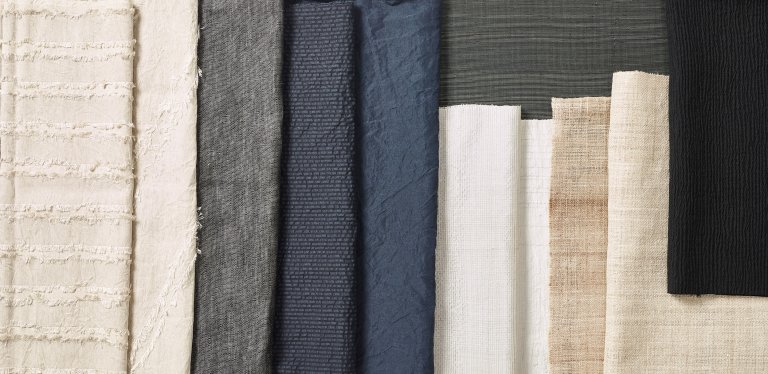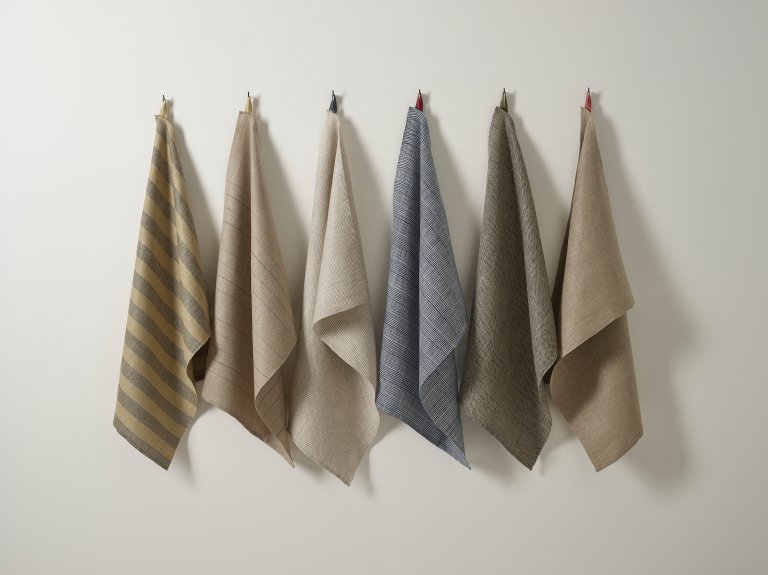His studies at the Surrey Institute of Art & Design in the UK later brought him to Okinawa, Japan. The impressions and experiences derived from this stay are subtly but surely present in Tim Parry-Williams’ work.
Tim invites me into his brand new studio space at KMD. Three partially assembled looms are visible amongst all the boxes with equipment and yarn stacked up in an orderly fashion on the floor and up against the walls. The busy schedule since starting in his position at KMD has pushed the chore of unpacking all the equipment and materials brought over from the UK to the background. We navigate a narrow aisle towards a desk and a couple of chairs.
The path towards textiles and weaving
Tim grew up in a very creative environment. An artist mother and a furniture making father ensured a life in a practical and creative family. Their home also surrounded him with books. “The early engagement with the art world programmed me to become accustomed to regularly attend exhibitions and openings,'' he explains. A one year period after school was spent doing a foundation course in art. This is where the initial interest in surface started to form, and it became clear that textile was the direction to go in. The craft-based, holistic teaching at the Surrey Institute of Art & Design in Farnham was a natural fit and he quickly fell in love with the subject. On the very first day of studies the students started by preparing and dressing a loom. This foundation act of equipment assembly let the students get to know the gentle machinery; its simple, systematic and ordered process of operation, and it awoke in Tim a natural affinity with craft and skill. “That first week I also realized I liked education in itself,” he says. “I recognized I had an ability to help others learn, and it became apparent that I had a double vocation.” The loom drew him in, and caused the definite shift from general interest in art and creative practice into surface and textiles. He never looked back.
The influence of living and studying in Okinawa, Japan
Tim’s epiphany in Okinawa was a wake up to raw materials. This understanding of material value was first triggered whilst standing in a banana plot, surrounded by the shrilling of insects, steam rising from the ground, as he participated in the harvesting of banana leaf fibre. He says “The process of converting plant material into fibre, then yarn for weaving made me understand the relationship between where a material comes from and how it will be in my hand.” More widely he became able to see the culture, history and processes in the very material of the weaving. While first a westerner looking at the content from outside, over time it became his internal vocabulary as a practitioner, and this knowledge has shaped him since.

He shows me a few samples of textiles he has hand woven in order for me to learn more about his artistic processes. It is hand dyed raw silk woven in a tight, yet delicate way. It almost floats between my fingers whilst maintaining a stiffness that makes me wonder how this can be at all achieved by a human hand. “A machine could really not achieve this, as it would be cold and hard in comparison,” he states. This is the manifestation of his technical skill in weaving and dyeing, and reveals a stubborn faith in the skill he has dedicated himself to. A man sticking to his guns.

Studying in Okinawa was in the end a form of going back to basics: a re-education, or double education, where Tim learned to navigate the wider world along with it. It taught him how to fit into different systems and knowing what is needed in order to make things happen. This international focus has proven valuable in his own work as an educator.
Artistic research dealing with the context of textile
I inquire about his ongoing and future projects. He exclaims “There is so much I want to do. My heart races when thinking about it!” A common denominator in his work is an aim to challenge the perceptions of textile by playing with understandings related to material traditions and culture. For example: to make things that are on the border of being too nice to use. It influences our relationship to them, and is an effective step in the opposite direction from throwaway culture. If it is of value to the owner, it will be treated accordingly. The use of renewable materials in his work sits well in the space for considering contemporary solutions for sustainability.
Tim is currently completing a long term project looking at historical textile archives, which began back in 2005. The result will be published in the Journal of Textile Design and Research Practice. The project revolves around textile sample books in an Anglo-Japanese context, where archives from Japan are compared with those from England, through a process of almost forensic cross-analysis. His projects have also led to collaborations with several designers like Hilde Stiegler Rubecksen, Anne Cordsen and Ian Batten, who have made limited edition garments from his woven textiles. He is certain of the possibility for future collaborations of this kind, set in a Norwegian context of artistic research, design and industrial production using local sustainable materials. Tim states “There is a lot to be gained from cross-institutional research and collaborations. Two minds are good together.”
The relationship between design and Fine Art in Tim’s practice
Tim sees himself as a craft practitioner: “Craft is a substantial part of what I do. It allows me to move quite freely between these definitions, and to express myself in the most appropriate way for projects in hand.” He describes his practice as one of creating substrates, where he ‘changes the recipe’ particularly when it comes to textile for fashion and interiors. He compares it to the act of making bread: “There is a set procedure with ingredients, but change it slightly, and you get substantial differences.” Subtlety is at the core of his work when exercising the knowledge he has acquired about materials, structure and finish. The work is grounded in these basics which let him merge tradition with contemporary aesthetic. “My artistic practice is about navigating my discipline in different ways, and exercising a stubborn faith in what I think is important.”
Textile in the contemporary art scene
“As part of an increasing sense of 'global citizenship', or responsibility and accountability, perhaps afforded by the real or imagined democracy of social media and popular culture platforms, there is a prevailing shift towards more politicised work addressing the human centred concerns of our times. Of course, this is perhaps what art has always been. But as such, post-colonialism and indeed post-humanism have become a normal and even expected part of the diaspora of contemporary artistic practice.” Tim reflects on the key conditions underpinning artistic expression, which informs a shift in the notions of making, and how something can be made, and made in a new way. Textile artworks are currently being made in a very process-visible way, making it accessible and interactive for the audience. He sees it as a strong encouragement to be reminded, and mindful of, the craft that has become lost in the prevailing culture of mass production since the mid-1900s. A re-awakening to the provenance in the making of things is happening, very much linked to increased focus on sustainability. When discussing the direction of the contemporary art scene, Tim states “Any artistic practice will inevitably represent the contemporary position in respect of both global issues and established traditions. You can’t un-know knowledge; it is there somewhere. We simply don’t have the freedom to be selfish artists, rather we should accommodate a more selfless view of the world whilst maintaining artistic integrity.”
Students as practitioners
Back to the three looms in Tim’s studio. His plans are to assemble them and make them available for students to use as an extension of the textile workshop at KMD. Tim’s teaching experience has shown him that to involve students in his work helps them to develop their skills and understanding. They seem to be open in a different way, and learn more, by participating in another’s practice. The work is taken seriously, and their acquired knowledge is passed to others. Tim explains that the term ‘review and reinforcement’ is quite fitting; to welcome someone to assist reinforces core knowledge. “Broadly, this is not about my practice, but enhancing theirs. Students need to have the capacity to be nimble, but not necessarily move around. We need to be sure that the education we give them is rich on every level. They need to experience thinking around an idea and how to conceptually develop it. As subject leader my task is to make sure the courses and teaching cultures are facilitating that knowledge development.” In the end, it is about building autonomous, creative and connected practitioners.
Facts
- Professor of Fine Art (Textiles) at The Art Academy – Department of Contemporary Art
- Bachelor and Master from the Surrey Institute of Art & Design (Now University for the Creative Arts 'UCA')
- Has taught at Bath Spa University, University of Art and Design Linz / Textile Centre Haslach and University of the Creative Arts in addition to design work for Alphatex Co. Ltd. Japan.
- Works mainly with textile weaving. Natural materials like linen are central to his artistic practice.